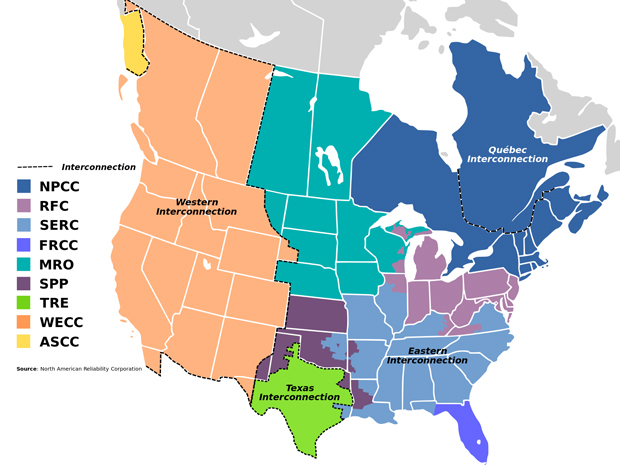
Time to Rightsize the Grid?
Apr 14, 2014 - Peter Fairlay - spectrum.ieee.org
 |
| Wikipedia |
Last week a team of systems scientists known for counter-intuitive insights on power grids delivered a fresh one that questions one of the tenets of grid design: bigger grids, they argue, may not make for better grids. University of Iowa electrical engineering professor Ian Dobson and physicists David Newman and Ben Carreras make the case for optimal sizing of power grids in last week's issue of the nonlinear sciences journal Chaos.
In a nutshell, the systems scientists use grid modeling to show that grid benefits such as frequency stabilization and power trading can be outweighed by the debilitating impacts of big blackouts. As grids grow larger, they become enablers for ever larger cascading blackouts. The Northeast Blackout of 2003 was a classic case. From a tripped line in northern Ohio, the outage cascaded in all directions to unplug more than 50 million people from western Michigan and Toronto to New York City.
This week's findings are more conceptual, however, than some news outlets would have us believe. NBC News, in an online article entitled Researchers Suggest It's Time to Downsize Power Grid, misjudged the Chaos report as a call to break up the dual grids that interconnect most of eastern and western North America. "It’s not possible to really make that statement," says Carreras, who runs Oak Ridge, TN-based consulting firm BACV Solutions and is a visiting professor at Madrid's Universidad Carlos III.
 |
| B.A. Carreras/BACV Solutions |
NBC misinterpreted Carreras et al's simulations showing that grids with just 700-1000 nodes (over 15 times smaller than North America's big grids) maximize interconnection benefits while minimizing blackout costs (see above chart). The researchers say this could indicate that some real grids are too large, but there are two big reasons to be cautious about drawing conclusions.
Carreras stresses that the model nodes are not necessarily representative of those on a real grid. Many of the group's simulations, for example, use scale models of the Western grid in which each node in the model represents, on average, 10 nodes on the real grid.
Newman, a physics professor at the University of Alaska in Fairbanks, notes that the specific models used in this Chaos study were idealized, homogeneous systems. As such, he says, they bear little resemblance to the heterogeneity of real grids with their diversity of voltage levels, branching patterns and other features. "700-1000 nodes was the optimal size for the artificial network we had constructed," says Newman.
Media hype is a problem that has dogged this team of system scientists since they gained notoriety over a decade ago by identifying cascading failures as an innate feature of power grids. Their simulations, which a Spectrum cover story profiled ten years ago, show that economic pressure to maximize return on investment loads power grids to levels that leave them at heightened risk of costly blackouts.
The researchers delivered a complex systems view of blackouts that they hoped would spur novel thinking about the costs and benefits in grid design, and novel approaches to blackout prevention. But their message was often misinterpreted as an attack on the quality of grid engineering, or an argument that trying to prevent blackouts was futile.
Carreras et al argue that this week's report has important conceptual value, if one gets beyond the hype. For one thing, blackout risks should be factored into the cost-benefit calculation when grid planners consider expanded interconnection. This could be applicable in developing countries as well as in Europe, which recently expanded its grid to include Turkey's and is considering extensions to North Africa and Russia.
It's also possible that grid design could be engineered to enable extended interconnection without expanding cascading blackout risk. Newman points to the possibility that weak links could be deliberately placed within grids to confine cascading blackouts to their region of origin. The team's next step, says Newman, is to study just that possibility by simulating and optimizing heterogeneous networks.

|



